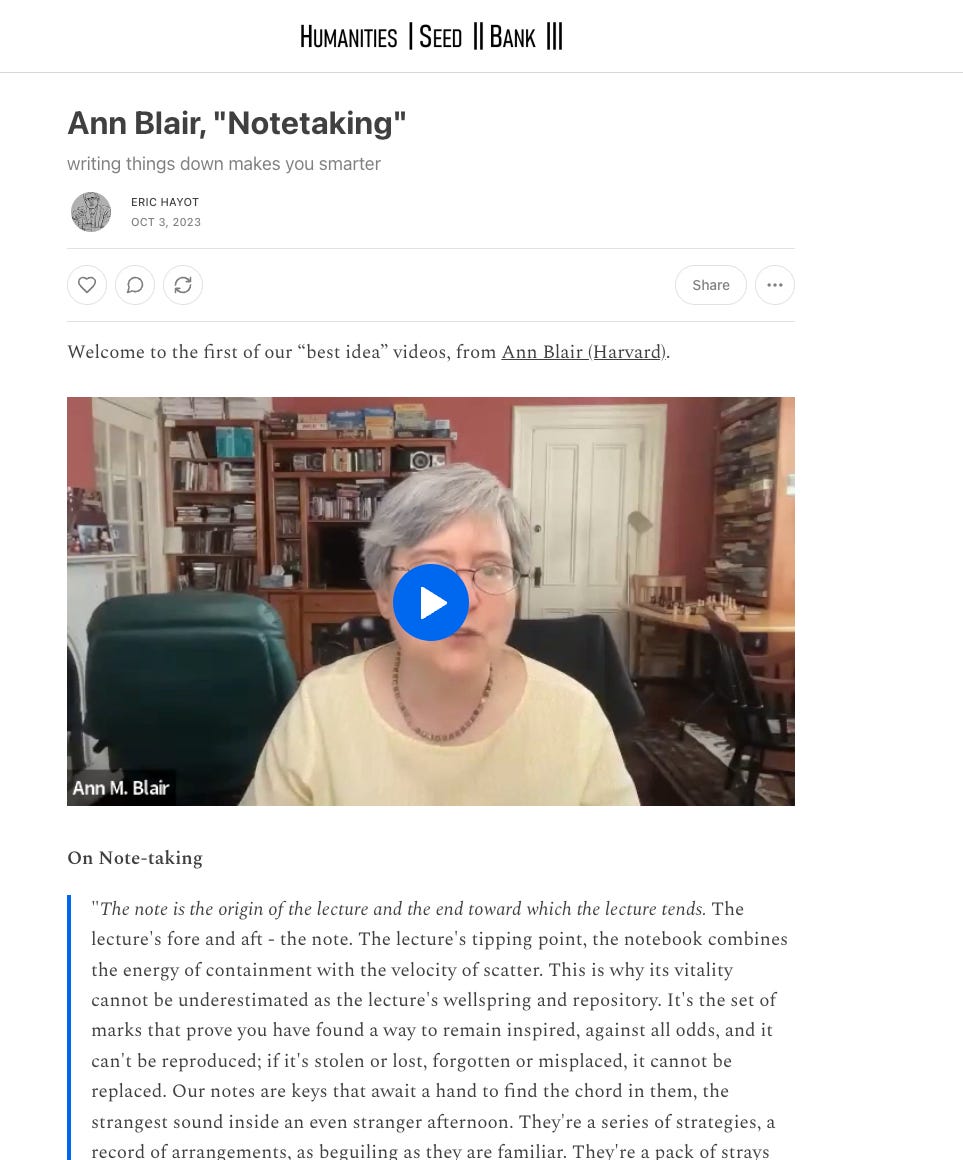Introducing: Humanities Seed Bank
You may have seen the recent essay by Agnes Callard in the Opinion section of the NYT. Defense of the humanities (or not), etc etc. I tend not to get too exercised about this kind of thing. The Humanities. Capital T, Capital H. That's not to say that I don't care deeply about the realm in which I arguably spend most of my vital essence. (If I were a podling drained of such by an evil Skeksis, for example, that essence would likely be humanities-flavored.)(If you don't get that reference, stay tuned because I have even more generational nods to films like Labyrinth and Goonies comin' atcha in future weeks.) Rather, I tend not to be able to think/act/motivate at larger scales. The field. The discipline. The society. The humanities. Give me one-on-one relationships, give me a classroom, and I know how to move. Drop me into anything grander than that, and I'm generally flailing around and looking for a place to land.
With that said, as unfortunate and misleading as the title of that NYT piece was, something about the Callard essay rang true for me. Specifically: rather than proving or defending, my humanities-oriented actions lean much more toward attending, immersing, sharing, appreciating.
In that spirit, Eric Hayot and I have just launched the first season of a new project called Humanities Seed Bank. It's a free Substack, born out of years of conversations that Eric and I were having. Most recently, we were chatting about our individual re-orientations toward what was happening in our respective ‘lil areas of academia: we each felt that we were less interested, at this point in our careers, in rooting down into positions of ownership over ideas, or in fighting over this or that internal disciplinary battle. We were imagining what it might look like to dwell in a space where people were sharing insights freely, making things by planting idea-seeds to see what grew in their particular contextual soil. A spirit of gardening, of play, of let’s-just-start-and-do-something-and-see-where-we-go.
Thus: Humanities Seed Bank. The plan is to release a new video every Monday (with occasional holiday breaks) that each feature someone whose work we dig offering a seed for the vault: a good seed, a bad seed, or something in-between. After every three videos or so, Eric and I will post a brief conversation where we reflect on that recent batch of ideas and what they spark for us.
Check us out! I'll post, below, the write-up I did for the first Seed Bank video, featuring the phenomenal Ann Blair.
See you back here soon! Now that classes are wrapping up, I'll be in your inboxes with a bit more regularity in the weeks to come. - Carla xo
(Reposted from Humanities Seed Bank, below.)
On Note-taking
"The note is the origin of the lecture and the end toward which the lecture tends. The lecture's fore and aft - the note. The lecture's tipping point, the notebook combines the energy of containment with the velocity of scatter. This is why its vitality cannot be underestimated as the lecture's wellspring and repository. It's the set of marks that prove you have found a way to remain inspired, against all odds, and it can't be reproduced; if it's stolen or lost, forgotten or misplaced, it cannot be replaced. Our notes are keys that await a hand to find the chord in them, the strangest sound inside an even stranger afternoon. They're a series of strategies, a record of arrangements, as beguiling as they are familiar. They're a pack of strays that cannot be corralled for all their mewling." (Mary Cappello, Lecture)
"Note 227. It happened again. I thought of something and then I picked up the phone to call my mother or Stephen because I wanted to ask them if they'd read something or tell them about that something and laugh, but they are both dead. After twenty-four years, after eight years, how is it still possible that I reach for the phone to call you? … Note 242. I write these ordinary things to detail the everyday sonic and haptic vocabularies of living life under these brutal regimes. … Note 248. This is a love letter to my mother." (Christina Sharpe, Ordinary Notes)
There are a lot of reasons why we take notes. Some of us make notes as a practice of living, as an aspect of our craft. It's how we think. It's how we make things. It's how we reach out into time, or root ourselves there. It’s how we love.
And some of us are interested in the practice of note-taking itself. We geek out over Niklas Luhmann's Zettelkasten system. We carry notecards and pens in our pockets. We keep track of readings and lectures in programs like Roam Research. Our desks are covered in post-its. We are decomposers, fragmenters, re-arrangers, connectors.
In this seed, Ann Blair reflects on the act of note-taking as a practice of attention. You will find, here, thoughts on the activities that comprise note-taking as activity: selecting, summarizing, paraphrasing, cutting-and-pasting, storing, connecting, going-back-to, slowing-down. Note-taking has its hazards as well as its affordances, and you will find some tricks to try to mitigate those hazards. You will find thoughts on the relationship between the burial and the discovery of things, on the creative practice of making new ways of being next-to.
You might want to take notes.



